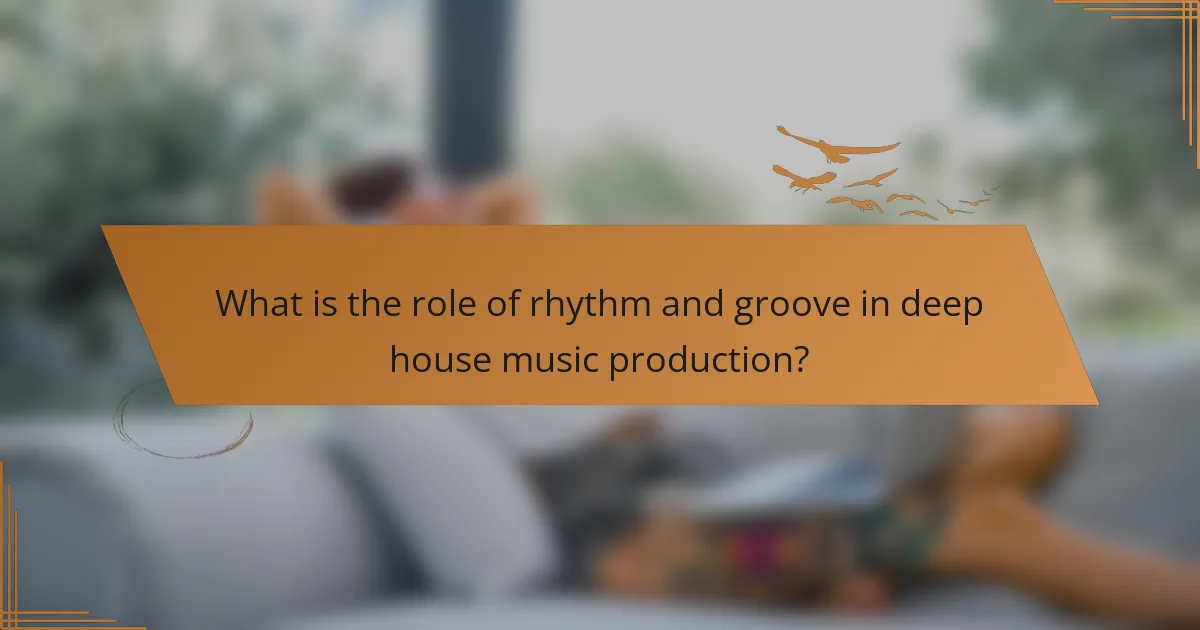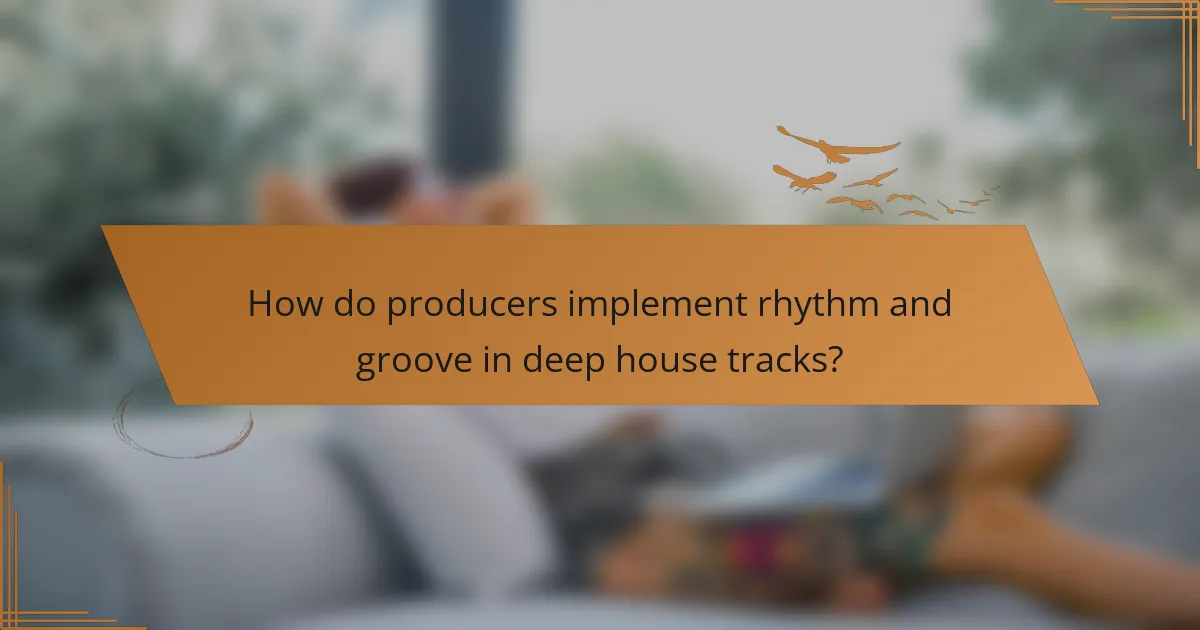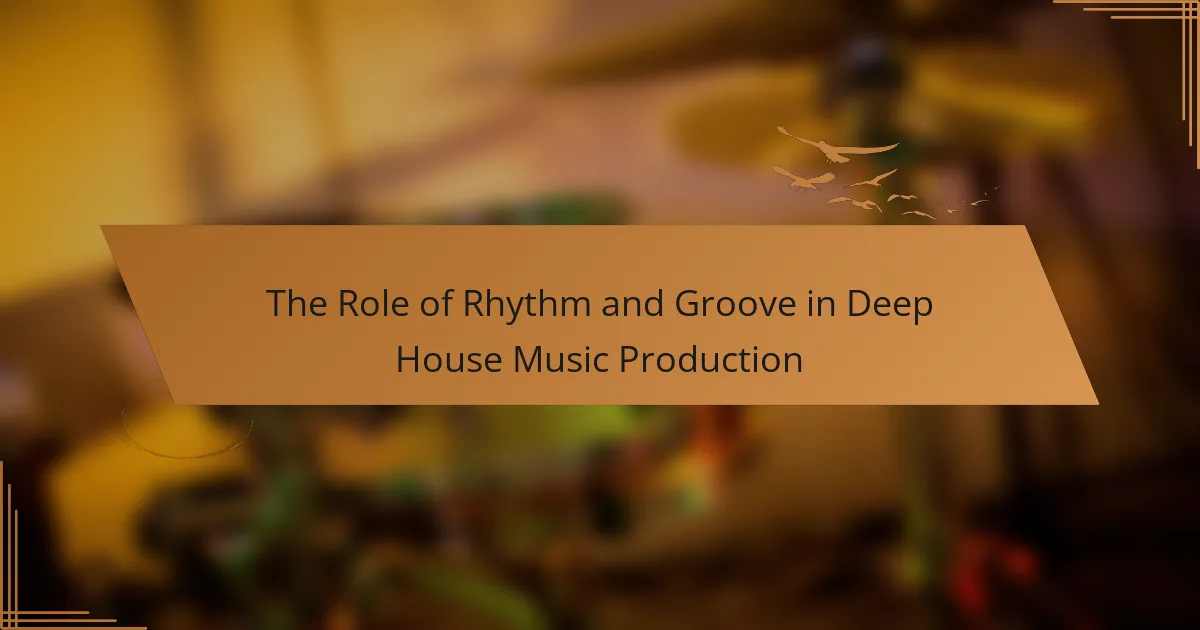Rhythm and groove are fundamental components of deep house music production, shaping the track’s overall feel and movement. Rhythm defines the timing and pattern of beats, while groove introduces a sense of swing and flow, enhancing listener engagement and danceability. Deep house typically features syncopated rhythms and dynamic basslines that emphasize groove, contributing to a rich listening experience. Producers face challenges in maintaining consistent timing, balancing rhythmic elements, and achieving the right swing, all of which are crucial for effective rhythm and groove in deep house tracks. This article explores the interplay between rhythm and groove, their implementation in production, and the challenges faced by producers in creating compelling deep house music.

What is the role of rhythm and groove in deep house music production?
Rhythm and groove are essential elements in deep house music production. They create the foundation for the track’s overall feel and movement. Rhythm establishes the timing and pattern of beats, while groove adds a sense of swing and flow. Together, they enhance listener engagement and drive the danceability of the music. Deep house typically employs syncopated rhythms, which contribute to its unique sound. The use of basslines in deep house often emphasizes the groove, making it feel more dynamic. This interplay between rhythm and groove is crucial for maintaining energy on the dance floor. Studies have shown that tracks with compelling grooves are more likely to be favored by listeners in club settings. Therefore, effective rhythm and groove are vital for successful deep house music production.
How do rhythm and groove define deep house music?
Rhythm and groove are essential elements that define deep house music. Rhythm provides the foundational beat structure, usually characterized by a steady four-on-the-floor kick drum pattern. This creates a consistent pulse that invites movement and dance. Groove, on the other hand, refers to the syncopated patterns and interactions between various instrumental elements. These elements often include hi-hats, snares, and basslines that create a flowing, laid-back feel.
Deep house music typically features a slower tempo, ranging from 120 to 125 BPM. This tempo allows for a relaxed yet engaging listening experience. The interplay between rhythm and groove creates a lush soundscape, often enhanced by atmospheric pads and melodic elements. This combination results in a captivating auditory experience that encourages both introspection and dance.
In deep house, the groove is often emphasized through swing and shuffle techniques. These techniques enhance the rhythmic complexity and create a more organic feel. The use of both rhythm and groove is crucial in establishing the genre’s signature sound.
What are the key characteristics of rhythm in deep house?
The key characteristics of rhythm in deep house include a steady four-on-the-floor beat, syncopated hi-hat patterns, and intricate basslines. The four-on-the-floor beat provides a consistent foundation, typically at a tempo of 120 to 125 BPM. Syncopated hi-hat patterns add complexity and groove, creating a danceable feel. Basslines in deep house are often deep and smooth, enhancing the rhythmic texture. Additionally, the use of off-beat claps or snares contributes to the overall groove. These elements combine to create a rich rhythmic landscape that defines deep house music.
How does groove contribute to the overall feel of deep house tracks?
Groove is essential in shaping the overall feel of deep house tracks. It creates a rhythmic foundation that drives the music forward. A strong groove encourages movement and engagement from listeners. This rhythmic quality often features syncopated basslines and intricate drum patterns. These elements contribute to a laid-back yet danceable vibe. The interplay between various instruments enhances the track’s emotional depth. Additionally, groove fosters a sense of connection between the artist and audience. Ultimately, it defines the unique character of deep house music.
Why are rhythm and groove important in music production?
Rhythm and groove are essential in music production because they create the foundation for a track’s feel and movement. Rhythm provides the timing and structure that guide the listener’s experience. Groove refers to the swing and feel that makes music engaging and danceable. Together, they enhance the emotional impact of a song. Research shows that tracks with strong rhythmic elements are more likely to be perceived as enjoyable. A study by the University of Cambridge found that groove influences listeners’ desire to dance. This demonstrates that rhythm and groove significantly affect listener engagement and overall enjoyment in music production.
How do rhythm and groove enhance listener engagement?
Rhythm and groove enhance listener engagement by creating a compelling musical foundation. A strong rhythm provides a steady pulse that encourages movement and connection. Groove adds a layer of complexity, making the music feel more alive and dynamic. This combination captivates listeners, drawing them into the experience. Research shows that rhythmic elements can trigger emotional responses, increasing enjoyment. For example, a study by the University of California found that rhythmic patterns can influence physical responses, such as dancing. Engaging rhythms and grooves foster a deeper connection between the music and the listener. This connection is essential in genres like deep house, where immersion is key.
What impact do rhythm and groove have on danceability?
Rhythm and groove significantly enhance danceability. A strong rhythm provides a structured beat that guides movement. Groove adds a unique feel, creating a compelling urge to dance. Together, they create a synergy that resonates with dancers. Tracks with consistent rhythm often have higher danceability scores. Research shows that songs with pronounced grooves engage listeners more effectively. For example, studies indicate that rhythmic complexity can increase physical response in dancers. This connection between rhythm, groove, and danceability is essential in genres like deep house music.

How do producers implement rhythm and groove in deep house tracks?
Producers implement rhythm and groove in deep house tracks through the use of syncopated basslines and intricate drum patterns. Syncopation creates a sense of movement and unpredictability in the rhythm. Deep house often features a four-on-the-floor kick drum pattern, which provides a steady pulse. Producers layer hi-hats and claps to add texture and complexity to the groove. Additionally, swing and shuffle techniques are utilized to enhance the feel of the track. The tempo typically ranges from 120 to 125 BPM, allowing for a laid-back yet danceable vibe. Groove is further developed by manipulating the timing of elements, creating a more human feel. This combination results in a rich, immersive listening experience that characterizes deep house music.
What techniques do producers use to create rhythmic patterns?
Producers use several techniques to create rhythmic patterns in music. Common methods include layering drum sounds, using syncopation, and employing swing. Layering involves stacking multiple percussive elements to build complexity. Syncopation creates unexpected accents, adding interest to the rhythm. Swing modifies the timing of notes for a laid-back feel. Additionally, producers utilize quantization to align beats precisely. They may also apply polyrhythms, combining different rhythmic patterns. Each technique contributes to the overall groove and drive of the track.
How can layering different percussion elements enhance rhythm?
Layering different percussion elements enhances rhythm by creating a more complex and engaging sound. This technique adds depth and texture to the overall musical composition. Each percussion element can play a unique role, contributing to the groove. For example, a kick drum may provide a strong downbeat, while hi-hats can add syncopation. The combination of these elements can create a fuller rhythmic experience. Research shows that varied percussion layers can improve listener engagement and emotional response. This is evident in genres like deep house, where rhythm plays a crucial role in maintaining energy on the dance floor.
What role does tempo play in establishing groove?
Tempo is crucial in establishing groove. It sets the pace at which music is played. In deep house music, common tempos range from 120 to 125 beats per minute. This range allows for a relaxed yet danceable feel. The relationship between tempo and rhythm creates a sense of movement. A consistent tempo helps musicians lock into a groove. Variations in tempo can enhance the dynamic feel of a track. Ultimately, tempo influences listener engagement and danceability.
How can groove be manipulated in deep house music?
Groove in deep house music can be manipulated through various techniques. Producers often adjust the timing of individual elements, creating a swing feel. This can involve shifting the kick drum or hi-hats slightly off the grid. Layering different rhythms also enhances groove complexity. Using syncopation adds unexpected accents, making the rhythm more engaging. Additionally, varying the velocity of notes contributes to a more human feel. Effects like reverb and delay can further enhance the groove by adding depth. The combination of these techniques creates a compelling rhythmic foundation in deep house tracks.
What are swing and shuffle, and how do they affect groove?
Swing and shuffle are rhythmic techniques that alter the timing of notes. Swing involves delaying the second half of a pair of notes, creating a bouncy feel. Shuffle, on the other hand, divides the beat into uneven triplet subdivisions. Both techniques enhance groove by adding a sense of movement and syncopation. This makes the rhythm feel more dynamic and engaging. In deep house music, these techniques are often used to create a laid-back yet driving feel. Their application can lead to a more infectious groove, encouraging listeners to dance.
How can quantization be used to refine rhythmic elements?
Quantization can be used to refine rhythmic elements by aligning musical notes to a predefined grid. This process enhances timing accuracy and consistency in rhythmic patterns. Quantization allows producers to correct slight timing errors in performances. It can create a tighter groove by ensuring that beats fall exactly on the desired subdivisions. Additionally, quantization can be applied selectively to maintain a natural feel while improving overall rhythm. Many digital audio workstations (DAWs) offer quantization features that allow for customizable settings. This flexibility enables producers to achieve the desired swing or groove effect. Quantization is a fundamental tool in modern music production, especially in genres like deep house.

What are the challenges in achieving effective rhythm and groove?
Achieving effective rhythm and groove presents several challenges. One challenge is maintaining consistent timing throughout the track. Inconsistent timing can disrupt the overall feel and flow. Another challenge is balancing various rhythmic elements. This includes drums, basslines, and melodic components. If these elements clash, the groove suffers. Additionally, achieving the right swing or shuffle can be difficult. Too much or too little swing alters the intended groove. Layering different rhythms also poses a challenge. It requires careful mixing to avoid muddiness. Lastly, the creative process can lead to overthinking. This can hinder the natural feel of the rhythm. Collectively, these challenges impact the effectiveness of rhythm and groove in deep house music production.
What common pitfalls do producers face when creating rhythm?
Producers often face several common pitfalls when creating rhythm. One significant issue is overcomplication. Many producers add too many elements, which can clutter the mix. This results in a lack of clarity and focus in the rhythm. Another pitfall is neglecting groove. A rhythm without a strong groove can feel mechanical and lifeless. Additionally, poor quantization can lead to a rigid feel. Overly quantized rhythms can strip away the natural swing and human touch.
Producers may also struggle with balancing elements. If the kick drum is too loud, it can overshadow other percussive elements. This imbalance disrupts the overall rhythm. Lastly, failing to experiment with different time signatures can limit creativity. Sticking to standard 4/4 time can make the rhythm predictable. These pitfalls can hinder the effectiveness and uniqueness of a track.
How can overcomplication detract from the groove?
Overcomplication can detract from the groove by disrupting the rhythmic flow. When elements are added unnecessarily, they can create confusion in the listener’s perception. This confusion can lead to a loss of engagement with the music. A clear and consistent rhythm is essential for maintaining a groove. Research shows that simplicity often enhances listener enjoyment in music. Complex arrangements can overshadow the core rhythmic elements. In deep house music, the groove relies on repetitive patterns. If these patterns become too intricate, the foundational beat may be lost. Thus, overcomplication undermines the intended emotional impact of the groove.
What strategies can help maintain a cohesive rhythm throughout a track?
To maintain a cohesive rhythm throughout a track, use consistent tempo and time signature. This ensures a stable foundation for the groove. Incorporate repetitive elements, such as loops or motifs, to create familiarity. Utilize rhythmic variations sparingly to keep the listener engaged without losing coherence. Layer percussion instruments strategically to build complexity while preserving unity. Employ sidechain compression to enhance the interaction between bass and kick drum, reinforcing the rhythm. Regularly reference the main rhythmic theme to anchor the listener’s experience. These strategies are essential in deep house music, where groove is paramount for danceability.
How can producers troubleshoot rhythm and groove issues?
Producers can troubleshoot rhythm and groove issues by analyzing the timing of each element in the mix. They should check the alignment of beats and ensure they are quantized correctly. Listening critically to the track can help identify any inconsistencies in rhythm. Adjusting the swing settings on drum patterns can enhance groove. Layering different percussion sounds can add depth and complexity to the rhythm. Utilizing a metronome can provide a consistent reference point for timing. Additionally, experimenting with different tempos may improve the overall feel of the track. These methods are widely used in music production to achieve a polished and cohesive sound.
What techniques can be used to identify and fix rhythmic inconsistencies?
Techniques to identify and fix rhythmic inconsistencies include using a metronome, analyzing waveforms, and employing quantization. A metronome helps maintain consistent timing during recording. Analyzing waveforms visually reveals discrepancies in timing. Quantization can correct timing issues by aligning notes to a grid. Additionally, using loop playback allows for focused listening to detect inconsistencies. Adjusting velocity and swing settings can also enhance the groove. These methods are essential in deep house music production to ensure a polished final product.
How can feedback from listeners improve rhythm and groove in tracks?
Feedback from listeners can enhance rhythm and groove in tracks by providing insights on listener engagement. When listeners express their reactions, producers can identify which rhythmic elements resonate well. This can lead to adjustments that create a more compelling groove. For instance, if feedback indicates a section feels too repetitive, producers can modify the rhythm to introduce variation.
Additionally, listener feedback can highlight the effectiveness of syncopation and timing. If listeners respond positively to specific rhythmic patterns, producers can incorporate similar elements in future tracks. Research shows that audience engagement is crucial for music production. According to a study by the University of Southern California, tracks that align with listener preferences tend to receive higher play counts.
Thus, incorporating listener feedback directly influences the rhythmic and groovy aspects of music, leading to more engaging tracks.
What best practices can enhance rhythm and groove in deep house music production?
To enhance rhythm and groove in deep house music production, utilize swing and shuffle techniques. These techniques create a more human feel in the rhythm. Layering percussion elements adds depth and complexity. Use subtle variations in timing and velocity for each hit. This helps maintain listener interest and creates a dynamic groove. Incorporating off-beat hi-hats can also enhance the rhythmic flow. Experimenting with syncopation adds unexpected elements to the beat. Lastly, maintaining a steady bassline anchors the groove, ensuring consistency throughout the track.
How can experimentation with different sounds improve groove?
Experimentation with different sounds can enhance groove by introducing diverse rhythmic textures. This variation can create a more engaging listening experience. For instance, layering percussive elements with unique timbres can add depth. Incorporating unexpected sounds can disrupt monotony and stimulate interest. Studies show that rhythmic complexity can increase listener engagement, as seen in genres like deep house. Additionally, using unconventional samples can foster creativity, leading to innovative grooves. Ultimately, exploring various sounds allows producers to craft distinct musical identities.
What resources are available for learning more about rhythm and groove in music production?
Online courses are available for learning about rhythm and groove in music production. Websites like Coursera and Udemy offer structured courses on music production. Books such as “The Art of Music Production” by Richard James Burgess provide in-depth knowledge. YouTube channels like ADSR Music Production and Point Blank Music School offer free tutorials. Forums like Gearslutz and Reddit’s r/WeAreTheMusicMakers provide community support and insights. Additionally, software manuals for DAWs like Ableton Live include sections on rhythm and groove techniques. These resources collectively enhance understanding of rhythm and groove in music production.
The main entity of this article is rhythm and groove in deep house music production. The article explores the critical roles that rhythm and groove play in defining the genre, emphasizing their impact on listener engagement and danceability. Key characteristics of rhythm, such as the four-on-the-floor beat and syncopated patterns, are discussed, alongside techniques producers use to implement and manipulate these elements. Furthermore, the article addresses the challenges producers face in achieving effective rhythm and groove, including common pitfalls and best practices for enhancing the overall sound of deep house tracks.
